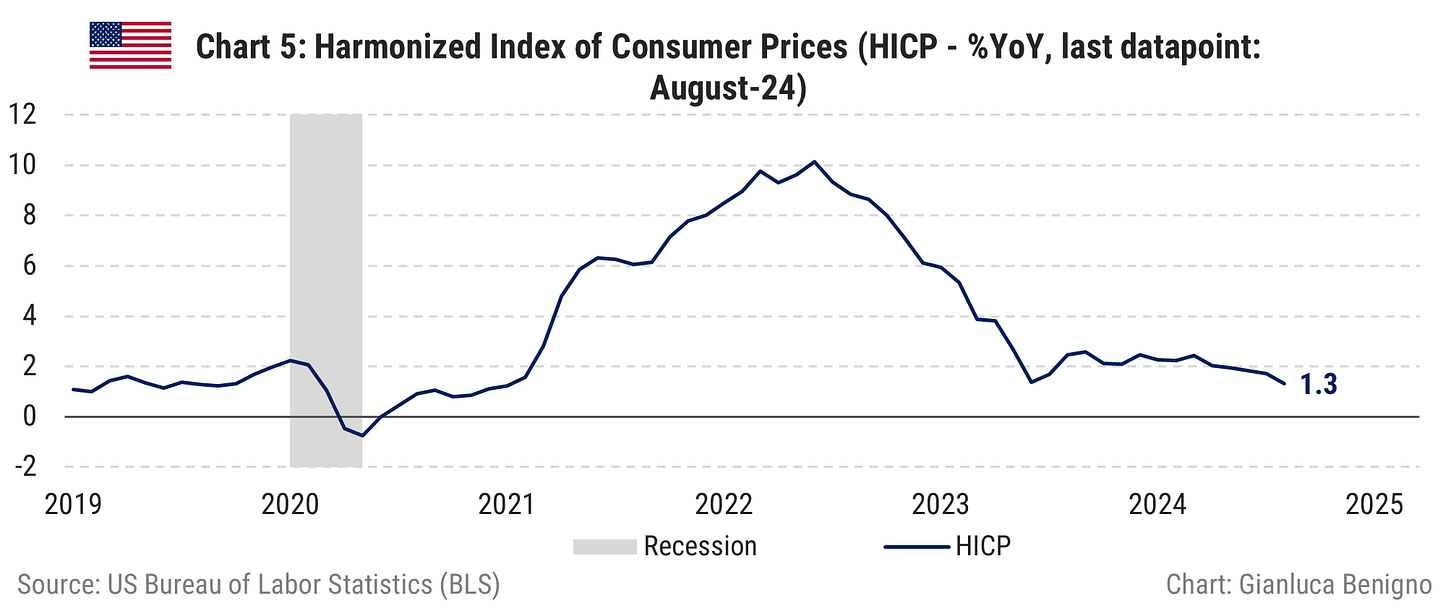U.S. August-24 CPI Inflation Report
The uptick in Core CPI and the slow adjustment of Core Service inflation suggest a gradual approach to rate cuts.
Key takeaways:
The overall Consumer Price Index (CPI, s.a.) increased by 2.6% year-on-year (YoY) in August, in line with the consensus expectation of 2.6% YoY and below the July reading of 2.9% YoY increase.
Core CPI in August was 3.3% YoY (s.a.), which is higher than the consensus forecast and July’s reading, both at 3.2% YoY.
Once more, inflationary pressures are primarily concentrated in the core service sector with an increase of 4.9% year-on-year, the same increase as in July. In contrast, the goods sector is experiencing deflation with a decrease of 1.7% year-on-year, the same rate as the one recorded in July.
The primary factor behind recent inflationary pressures is still the shelter component of the Consumer Price Index (CPI). Shelter increased by 5.2% YoY in August compared to 5.1% YoY in July. The month-on-month increase was 0.5%, higher than July’s 0.3% MoM.
The current reading is consistent with a benign disinflationary process and the start of the easing cycle by the Fed in September. Although disinflationary forces are at work, the continued inflationary pressures in the service sector were somewhat unexpected both at the monthly and yearly readings. With the FOMC's attention now largely on the labor market, the ongoing persistence of service-sector inflation suggests that a 25 basis point rate cut is likely at the September 18th meeting. (see also Post FOMC update: The Fed and the Market Shifts).
Related posts (with links)
US July-24 CPI Inflation Report (previous release)
US June-24 CPI Inflation Report (previous release);
US May-24 CPI Inflation Report (previous release);
Post FOMC update: the Fed and the Market Shifts (context post);
Japan July-24 CPI Inflation Report (other release);
UK July-24 CPI Inflation Report (other release);
Switzerland July-24 CPI Inflation Report (other release);
Review of the Inflation Release
The Consumer Price Index (CPI) rose by 2.6% year-on-year in August (Chart 1), which is in line with the market consensus (2.6% YoY) and below July’s figure of 2.9% YoY. On a month-on-month basis, there was an increase of 0.2%, in line with the market consensus and July’s figure, both of 0.2% MoM, indicating a further easing of price pressures.
Core CPI (excluding food and energy) increased by 3.3 % year-on-year (Chart 1), higher than the market consensus and July’s figure, both of 3.2% YoY. On a month-on-month basis, core CPI rose by 0.3%, higher than the 0.2% recorded in July and the consensus forecast of 0.2% MoM.
Core services (services excluding energy) remain the primary driver of inflationary pressures. In August, core services increased by 4.9% YoY (the same rate as in July), while core goods (goods excluding energy) experienced another decline, by 1.7% YoY (the same rate as in July). The current release confirms a slow adjustment of core CPI, with a month-to-month reading surprisingly higher than expected.
The following chart (Chart 2) illustrates this dichotomy between core goods and core services:
As anticipated, the CPI in August was primarily driven by the housing component (Tables 1 and 2). The overall shelter component rose by 5.2% year-on-year in August, slightly higher than the 5.1% figure recorded in July.
Supercore services (core services excluding shelter – Chart 3) increased by 4.3% year-on-year, moderating further relative to the 4.6% increase in July. On a monthly basis, the supercore component has increased by 0.1% MoM higher than the flat reading observed in July.
Core services (excluding energy) prices increased by 4.9% year-on-year in August, the same rate as in July. On a month-on-month basis, core services increased by 0.4%, higher than the 0.3% rise in July, and the 0.1% increase in June.
Core goods (excluding food and energy) prices continued their deflationary trend, declining by 1.7% year-on-year in August, the same rate as the decline in July. Most subcategories within core goods registered declining prices on a year-on-year basis. A similar pattern is observed in the month-on-month variation, with core goods decreasing at 0.2% month-on-month in August, lower than the decline of 0.3% MoM in July and higher than the decline of 0.1% MoM in June.
The Bureau also published the Harmonized Index of Consumer Prices (HICP), following the ECB’s methodology. According to the BLS: “The HICP differs from the U.S. Consumer Price Index (CPI) in two major respects. First, the HICP includes the rural population in its scope. Second, and probably more importantly, the HICP excludes owner-occupied housing”.
Chart 5 reveals that by excluding the owner-occupier rent component from the CPI, the inflation rate is lower, at 1.3% in August compared to 1.7% year-on-year in July 2024. This month's figure is the lowest since January 2021, when it reached 1.2% yoy.
Summary
The persistence of above-target inflation has postponed the Fed's beginning of the easing cycle. The recent release shows an uptick in core inflation on a month-on-month basis, particularly in the core service component, which has trended higher in the last three months. However, considering the broader easing of inflationary pressures and the shift in risk assessment highlighted by FOMC members, we can anticipate a gradual approach to interest rate cuts unless there is a significant downturn in the labor market.
Table 1: CPI by components (% YoY)
Source: Bureau of Labor Statistics (BLS)
Table 2: CPI by components (% MoM)
Source: Bureau of Labor Statistics (BLS)











I prefer the seasonally adjusted as well as they are better revealing of the underlying inflationary pressures. Most likely I think it is a matter of preferences given that differences are not big.
Interesting that media reports and the BLS itself emphasise the 12 month change on a not seasonally adjusted basis, whereas you use sa dat (which is what I do). NSA chages are slightly lower. Is there any good reason for using NSA 12 month rates of change?